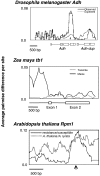Applications of selective neutrality tests to molecular ecology
- PMID: 12144648
- PMCID: PMC7201874
- DOI: 10.1046/j.1365-294x.2002.01536.x
Applications of selective neutrality tests to molecular ecology
Abstract
This paper reviews how statistical tests of neutrality have been used to address questions in molecular ecology are reviewed. The work consists of four major parts: a brief review of the current status of the neutral theory; a review of several particularly interesting examples of how statistical tests of neutrality have led to insight into ecological problems; a brief discussion of the pitfalls of assuming a strictly neutral model if it is false; and a discussion of some of the opportunities and problems that molecular ecologists face when using neutrality tests to study natural selection.
Figures


References
-
- Andersson L (2001) Genetic dissection of phenotypic diversity in farm animals. Nature Genetics Reviews, 2, 130–138. - PubMed
-
- Andrews TD, Easteal S (2000) Evolutionary rate acceleration of cytochrome c oxidase subunit I in simian primates. Journal of Molecular Evolution, 50, 562–568. - PubMed
-
- Aquadro CF, Begun DJ, Kindahl EC (1994) Selection, recombination, and DNA polymorphism in Drosophila In: Non‐Neutral Evolution: Theories and Molecular Data (ed. Golding B.), pp. 46–56. Chapman & Hall, New York.
Publication types
MeSH terms
LinkOut - more resources
Full Text Sources

